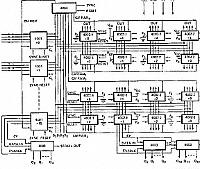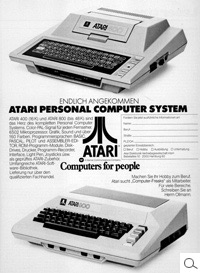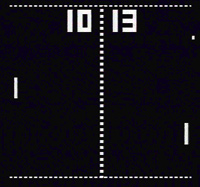This generation can be characterized by both the jump to monolithic integrated circuits (millions of transistors put onto one integrated circuit chip) and the invention of the microprocessor (a single chip that could do all the processing of a full-scale computer). By putting millions of transistors onto one single chip more calculation and faster speeds could be reached by computers. Because electricity travels about a foot in a billionth of a second, the smaller the distance the greater the speed of computers.
However what really triggered the tremendous growth of computers and its significant impact on our lives is the invention of the microprocessor. Ted Hoff, employed by Intel (Robert Noyce’s new company) invented a chip the size of a pencil eraser that could do all the computing and logic work of a computer. The microprocessor was made to be used in calculators, not computers. It led, however, to the invention of personal computers, or microcomputers.

Intel 4004
The first advertisement for a microprocessor, the Intel 4004, appeared in Electronic News. Developed for Busicom, a Japanese calculator maker, the 4004 had 2250 transistors and could perform up to 90,000 operations per second in four-bit chunks. Federico Faggin led the design and Ted Hoff led the architecture.
It wasn’t until the 1970’s that people began buying computer for personal use. One of the earliest personal computers was the Altair 8800 computer kit. In 1975 you could purchase this kit and put it together to make your own personal computer. In 1977 the Apple II was sold to the public and in1981 IBM entered the PC (personal computer) market.

Advertisement for Atari 400 and 800
Both sold well, though they had technical and marketing problems, and faced strong competition from the Apple II, Commodore PET, and TRS-80 computers.

Original Atari Pong Game
Pong is released. In 1966, Ralph Baer designed a ping-pong game for his Odyssey gaming console. Ralph Baer designed a ping-pong game for his Odyssey gaming console. Nolan Bushnell played this game at a Magnavox product show in Burlingame, California.Pong would revolutionize the arcade industry and launch the modern video game era.
Today we have all heard of Intel and its Pentium® Processors and now we know how it all got started. The computers of the next generation will have millions upon millions of transistors on one chip and will perform over a billion calculations in a single second. There is no end in sight for the computer movement
 Digital Equipment Corp. introduced the PDP-8, the first commercially successful minicomputer. The PDP-8 sold for $18,000, one-fifth the price of a small IBM 360 mainframe. The speed, small size, and reasonable cost enabled the PDP-8 to go into thousands of manufacturing plants, small businesses, and scientific laboratories.
Digital Equipment Corp. introduced the PDP-8, the first commercially successful minicomputer. The PDP-8 sold for $18,000, one-fifth the price of a small IBM 360 mainframe. The speed, small size, and reasonable cost enabled the PDP-8 to go into thousands of manufacturing plants, small businesses, and scientific laboratories. IBM´s 7000 series mainframes were the company´s first transistorized computers. At the top of the line of computers — all of which emerged significantly faster and more dependable than vacuum tube machines — sat the 7030, also known as the “Stretch.” Nine of the computers, which featured a 64-bit word and other innovations, were sold to national laboratories and other scientific users. L. R. Johnson first used the term “architecture” in describing the Stretch.
IBM´s 7000 series mainframes were the company´s first transistorized computers. At the top of the line of computers — all of which emerged significantly faster and more dependable than vacuum tube machines — sat the 7030, also known as the “Stretch.” Nine of the computers, which featured a 64-bit word and other innovations, were sold to national laboratories and other scientific users. L. R. Johnson first used the term “architecture” in describing the Stretch. John von Neumann wrote “First Draft of a Report on the EDVAC” in which he outlined the architecture of a stored-program computer. Electronic storage of programming information and data eliminated the need for the more clumsy methods of programming, such as punched paper tape — a concept that has characterized mainstream computer development since 1945. Hungarian-born von Neumann demonstrated prodigious expertise in hydrodynamics, ballistics, meteorology, game theory, statistics, and the use of mechanical devices for computation. After the war, he concentrated on the development of Princeton´s Institute for Advanced Studies computer and its copies around the world.
John von Neumann wrote “First Draft of a Report on the EDVAC” in which he outlined the architecture of a stored-program computer. Electronic storage of programming information and data eliminated the need for the more clumsy methods of programming, such as punched paper tape — a concept that has characterized mainstream computer development since 1945. Hungarian-born von Neumann demonstrated prodigious expertise in hydrodynamics, ballistics, meteorology, game theory, statistics, and the use of mechanical devices for computation. After the war, he concentrated on the development of Princeton´s Institute for Advanced Studies computer and its copies around the world. In February, the public got its first glimpse of the ENIAC, a machine built by John Mauchly and J. Presper Eckert that improved by 1,000 times on the speed of its contemporaries. (Start of project: 1943 / Completed: 1946 / Programmed: plug board and switches / Speed: 5,000 operations per second / Input/output: cards, lights, switches, plugs / Floor space: 1,000 square feet / Project leaders: John Mauchly and J. Presper Eckert.)
In February, the public got its first glimpse of the ENIAC, a machine built by John Mauchly and J. Presper Eckert that improved by 1,000 times on the speed of its contemporaries. (Start of project: 1943 / Completed: 1946 / Programmed: plug board and switches / Speed: 5,000 operations per second / Input/output: cards, lights, switches, plugs / Floor space: 1,000 square feet / Project leaders: John Mauchly and J. Presper Eckert.) On election night, November 4, CBS News borrowed a UNIVAC to make a scientific prediction of the outcome of the race for the presidency between Dwight D. Eisenhower and Adlai Stevenson. The opinion polls predicted a landslide in favor of Stevenson, but the UNIVAC´s analysis of early returns showed a clear victory for Eisenhower. Its sharp divergence from public opinion made newscasters Walter Cronkite and Charles Collingwood question the validity of the computer´s forecast, so they postponed announcing UNIVAC´s prediction until very late.
On election night, November 4, CBS News borrowed a UNIVAC to make a scientific prediction of the outcome of the race for the presidency between Dwight D. Eisenhower and Adlai Stevenson. The opinion polls predicted a landslide in favor of Stevenson, but the UNIVAC´s analysis of early returns showed a clear victory for Eisenhower. Its sharp divergence from public opinion made newscasters Walter Cronkite and Charles Collingwood question the validity of the computer´s forecast, so they postponed announcing UNIVAC´s prediction until very late.